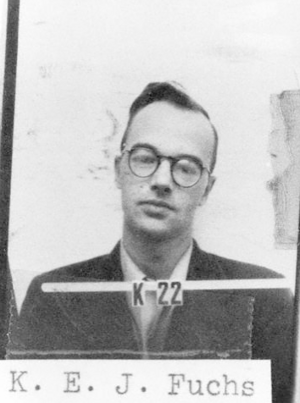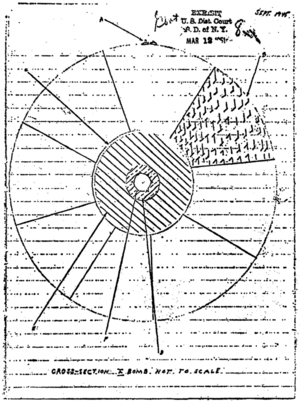Nuclear espionage facts for kids
Nuclear espionage is when someone secretly shares a country's information about nuclear weapons with other countries. This is done without permission. Since nuclear weapons were invented, there have been many known cases of nuclear spying. There have also been cases where spying was suspected but not proven.
Nuclear weapons are usually a country's most important secrets. Because of this, all nations with nuclear weapons have very strict rules. These rules stop people from sharing information about how nuclear weapons are designed. They also stop people from sharing where these weapons are kept. Countries that have signed agreements to stop the spread of nuclear weapons also have rules. These rules prevent them from sharing information about such weapons with the public.
Contents
Spies of the Manhattan Project
The Manhattan Project was a secret effort during World War II. The United States, the United Kingdom, and Canada worked together. Their goal was to build the first nuclear weapons. During this time, there was a lot of nuclear espionage. Scientists and technicians working on the project sent information to the Soviet Union.
These people are often called the "Atomic Spies." Their spying continued into the early Cold War. For a long time, there was much disagreement about the exact details of these cases. Some of this was cleared up when secret messages from the VENONA Project were made public. These were secret Soviet messages that were found and decoded. However, some questions still remain unanswered.
Some of the most well-known "Atomic Spies" were:
- Klaus Fuchs – He was a physicist who had fled Germany. He worked with the British at Los Alamos. This was during the Manhattan Project. He was eventually caught. He admitted what he did and was sent to jail in Britain. After being released, he moved to East Germany. Because he knew so much about the project, he is seen as the most valuable "Atomic Spy." He gave the Soviet Union important details about the American fission bomb program. He also gave early information about the American hydrogen bomb program. However, this information was not as useful later on.
- Theodore Hall – A young American physicist at Los Alamos. His spying was not found out until much later. He was never arrested for spying. He also never fully admitted to it.
- David Greenglass – An American machine worker at Los Alamos. Greenglass admitted that he gave simple drawings of lab experiments to the Soviet Union. This happened during World War II. Some parts of his story against his sister and brother-in-law (the Rosenbergs) are now thought to be made up. He might have done this to protect his wife. Greenglass admitted spying and was given a long prison sentence.
- George Koval – He was born in America to a family from Belarus. He moved to the Soviet Union. There, he joined the Red Army and the GRU intelligence service. He managed to join the US Army. He became a radiation health officer. He got information about the Urchin detonator. This was used on the plutonium bomb dropped on Nagasaki, Japan. The United States did not know about his work until 2007. After he died, he was recognized as a hero by Vladimir Putin in Russia.
- Ethel and Julius Rosenberg – Americans who were believed to be organizing a spy network. This network included David Greenglass. Most experts believe Julius was involved in some network. However, whether Ethel was involved or knew about it is still debated. Julius and Ethel refused to admit to any charges. They were found guilty and faced the highest penalty at Sing-Sing Prison.
- Harry Gold – An American who admitted working for Greenglass and Fuchs.
The Soviet Union tested its first atomic bomb in 1949. People disagree about whether this spying helped the Soviet Union build their bomb faster. Some information, like that from Klaus Fuchs, could have been very helpful. However, how the Soviet bomb project leaders actually used the information has made experts think it did not speed up the process much. They believe the information was mostly used to "check" their own scientists' work. Little of it was actually shared with Soviet scientists. This was because neither the scientists nor the spies were fully trusted. Later studies also showed that the biggest problem for the Soviets was not designing the weapons. It was getting the right materials.
Israel's Nuclear Program
In 1986, Mordechai Vanunu shared information about Israel's nuclear weapons program. He had worked at a nuclear facility in Israel. He gave the information to the British press. Before this, people thought Israel had a secret nuclear weapons program. Now, they knew for sure.
Israel has never said whether it has nuclear weapons or not. Vanunu was taken secretly to Israel. There, he was found guilty of treason and espionage.
Whether Vanunu was truly involved in espionage is debated. Vanunu and his supporters say he was a whistle-blower. A whistle-blower is someone who exposes something secret and wrong. His opponents think he is a traitor. They believe what he did helped Israel's enemies. After Vanunu left Israel, he did not share his information right away. He traveled for about a year before doing so.
China's Nuclear Secrets
In 1999, a report from the United States House of Representatives was released. It was called the Cox Report. This report said that U.S. security agencies believed there was nuclear espionage. They thought the People's Republic of China (PRC) was spying at American nuclear weapons design labs.
The report stated that China had "stolen secret information" since the 1970s. This included designs for America's most advanced nuclear warheads. It also included the neutron bomb design. China also got "weapons codes." These codes allow for computer tests of nuclear testing. This helps China improve its weapons without doing its own tests. The United States apparently did not know about this until 1995.
The investigations in the report led to the arrest of Wen Ho Lee. He was a scientist at Los Alamos. At first, he was accused of giving weapons information to China. However, the case against Lee eventually failed. He was only charged with mishandling data. Other people arrested or fined included scientist Peter Lee (not related to Wen Ho Lee). He was arrested for supposedly giving submarine radar secrets to China. Two companies, Loral Space & Communications and Hughes Electronics, also gave missile secrets to China. No other arrests have been made for the theft of the nuclear designs.
Pakistan's Nuclear Sales
In January 2004, Dr. Abdul Qadeer Khan admitted something. He was a Pakistani nuclear scientist. He admitted selling secret nuclear weapons technology to Libya, Iran, and North Korea.
According to his statements and intelligence reports, Khan sold designs for centrifuges. Centrifuges are machines used to enrich uranium. He also sold Chinese designs for a nuclear warhead. He sold the centrifuges themselves to these three countries. Khan had been accused before of taking gas centrifuge designs. He took them from a uranium enrichment company in the Netherlands (URENCO). He used these designs to help Pakistan start its own nuclear weapons program.
On February 5, 2004, Pakistan's president, General Pervez Musharraf, said he had pardoned Khan. Pakistan's government says they were not involved in the espionage. However, they refuse to let Khan be questioned by the International Atomic Energy Agency.
See also
 In Spanish: Espionaje nuclear para niños
In Spanish: Espionaje nuclear para niños



